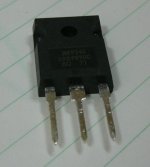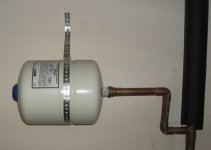There are actually 2 transistor locations (marked Q2 and J74) and 2 Rp and P1 locations on the daughter board. Pick one or they other and Peter's markings should be correct as far as I know.
Which means if i were to choose to use ZTX550, i will use Q2 and ignore the j74, and all P1,RP,RS,R4 and C5 which are on the side of the j74, is this correct?
For ZTX you leave out P1, Rp and J74 on one side, but still need 2 x R4's, 2 x C5's, 2 x Rs, 2 x Rg on the daughter board.Which means if i were to choose to use ZTX550, i will use Q2 and ignore the j74, and all P1,RP,RS,R4 and C5 which are on the side of the j74, is this correct?
I purchased 5 from that seller as well and had a good experience. The devices seem to be legit and as stated I believe that he had a reputable NOS source.
However, I also can not attest to the quality as I just received mine yesterday and am still collecting parts to build my five J-X's.
James
I received my fets from this seller. A very good ebayer. I've read someone saying that there are fakes components. I've brought some IRFP240 at a very good price per piece (please see img 'IRFP240'). Would they be fakes? How do one tell if it's a fake or original? Thanks.
Attachments
I'm curious about why the Aleph-j has a lower output into 4 ohms than 8, seems strange to me and I haven't found a layman's explanation why.
In laymans terms, it has been optimised for an 8ohm load. A 4ohm load requires twice the current at the same output voltage.
I'm curious about why the Aleph-j has a lower output into 4 ohms than 8, seems strange to me and I haven't found a layman's explanation why.
That is typical behavior for Single Ended output stages, the current source of the OPS determines the max output.
The output stage of a SE amp is alike two valves in a water pipe, with the valve nearest to the water source set to the desired max gallon/second flow rate.
The water pipe behind the valve bifurcates into a section that leads to the loudspeaker and a pipe part with the 2nd valve.
The consecutive valve is turned left and right, synchronous with the music signal, allowing more or less water to pass.
If it's less than what flows out the first valve, then the difference flows towards the loudspeaker.
If it's more, than the difference comes from the LSP.
In water pipe analogy, the LSP would be an expansion tank in a CH system, as in piccy=>
Attachments
thanks for the replys, I think I get it now, kind of like a cartoon light bulb over my head, hehe 🙂
Thats why there is the option for 3 pairs of output mosgets
I'm wondering what an extra pair of output devices per channel would gain me?
Just a few more watts and more heat. I like the J better in it's stock configuration, I tried the three fet deal and prefer two, but YMMV
I received my fets from this seller. A very good ebayer. I've read someone saying that there are fakes components. I've brought some IRFP240 at a very good price per piece (please see img 'IRFP240'). Would they be fakes? How do one tell if it's a fake or original? Thanks.
IRFP240's are such common parts, it's hard to imagine why
anybody would bother selling fakes. You can check them
by measuring Vgs, and see if they fall in the range of about
4.5 volts at 1 amp.
😎
Ok, that's what I figured. I'm going to stick with building the stock config, which will be ready for assembly once I get my custom panels from Front panel express in. Then I'll see if I'm happy with how loud it can drive my Zaph BAMTM speakers. They are 4 ohm with only about 84db sensitivity.
Was there a schematic of the Aleph J somewhere in this thread? I was pointed to this thread and I skimmed through and didn't see one.
Parallel or separate secondaries?
Hi everyone,
Based on several recommendations to go bigger, I have decided to use the 600VA Antek 18v + 18v transformer for my regular stereo (not x) J. If I use a separate bridge and CRC per channel, am I better off using each secondary to power its own channel, or should I parallel the secondaries and then split off to both channels? Why is one way better than another? Thanks!
-Alex
Hi everyone,
Based on several recommendations to go bigger, I have decided to use the 600VA Antek 18v + 18v transformer for my regular stereo (not x) J. If I use a separate bridge and CRC per channel, am I better off using each secondary to power its own channel, or should I parallel the secondaries and then split off to both channels? Why is one way better than another? Thanks!
-Alex
I just use 18v into bridge then CRC for +, and the other 18v into bridge, then CRC for - both channels. I just followed NP's FirstWatt formula and it works fine for all my clone amps.Hi everyone,
Based on several recommendations to go bigger, I have decided to use the 600VA Antek 18v + 18v transformer for my regular stereo (not x) J. If I use a separate bridge and CRC per channel, am I better off using each secondary to power its own channel, or should I parallel the secondaries and then split off to both channels? Why is one way better than another? Thanks!
-Alex
power supply inductor
I remember reading about inductors in the aleph power supplies, but for the life of me can't find that thread now. For a Stereo Aleph J, can you use a Goertz/Alpha core 12 Ga. 2,2mH inductor in a CLC design? Why or why not? If not, what alternative is recommended and what specs? thanks in advance!
-alex
I remember reading about inductors in the aleph power supplies, but for the life of me can't find that thread now. For a Stereo Aleph J, can you use a Goertz/Alpha core 12 Ga. 2,2mH inductor in a CLC design? Why or why not? If not, what alternative is recommended and what specs? thanks in advance!
-alex
- Home
- Amplifiers
- Pass Labs
- Aleph J-X Amp Project

